Human Flower Project
Garden Inspiration: Yin or Yang
Allen Bush, just back from a major conference of plantsmen, remembers two impossibilities and several mentors that sealed his gardening fate.
 Agastache ‘Tango’
Agastache ‘Tango’
Photo: Jelitto Seed
By Allen Bush
I’d barely shoved-off from the hotel curbside when the cab driver asked abruptly, “What’s your name?” I hadn’t swept the sleep from my eyes but I knew where this was going. It’s not commonplace anymore, but the Bush on my nametag still draws the occasional question: “Are you related to George Bush?” (I always feel like I’m being lobbed a soft one. )
“He’s my father.”
“You’re kidding?!”
My father’s name was George. When Bush the elder was President, besotted bar flies would occasionally get the fool idea to call the commander in chief in the middle of the night. My father was the only George Bush listed in the Louisville directory. (It must have been much too complicated to call Washington-D.C. directory assistance in the wee hours to get the White House switchboard.) Dad hung-up three or four times before he had his name taken out of the phone book. Listening to a slurred Pledge of Allegiance at 2:00 a.m was not his patriotic duty.
Moses, the Nigerian cab driver, talked non-stop for 15 minutes from downtown all the way up North Charles Street to the Sheppard Pratt Conference Center. I got an earful about politicians (none were to be trusted) and the Bushes. I wanted only a little quiet.
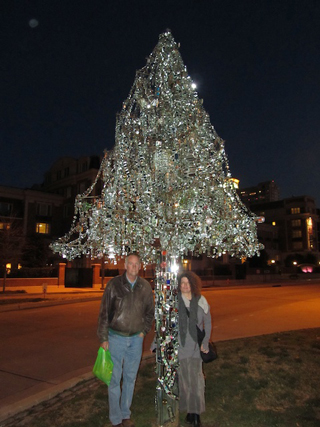 There’s more to plant conferences than new perennials. Ed Snodgrass and Mary Vaananen in front of Bob Benson’s Shiny Happy Tree at the American Visionary Arts Museum in Baltimore.
There’s more to plant conferences than new perennials. Ed Snodgrass and Mary Vaananen in front of Bob Benson’s Shiny Happy Tree at the American Visionary Arts Museum in Baltimore.
Photo: Allen Bush
I was heading to a garden conference to speak later in the morning and trying to wrap my head around what I was going to say. Moses, it turns-out, was interested in gardening, too. He asked me for the name of a grass seed variety that might work on a soccer field in Nigeria. He had a dream. But unfortunately I didn’t have a clue about tropical grasses. In the rearview mirror, Moses sized me up as unambiguously lightweight.
The room was packed at The Mid Atlantic Regional Symposium, a collaboration between the Perennial Plant Association and The Horticultural Society of Maryland. Two hundred good sports gave up a sunny, windy Saturday in late February to sit indoors in the dark. I hope they enjoyed the talks as much as I did. I’ve been going to garden conferences for over 30 years – mostly as an eager attendee, but from time to time as a speaker.
Some conferences are better than others. I am glad my pal, Janet Draper, the talented head “digger” at the Smithsonian’s Mary Livingston Ripley Garden, invited me. How could I turn down Janet? (The Ripley Garden should not be missed, if you’re walking the mall in Washington, D.C.)
And how can I thank her? All too often at conferences, speakers are going in the same direction, with one talk after another and slide after slide of brand spanking new plants. The presentations begin to sound like unending group therapy after awhile. But this didn’t happen in Baltimore.
For all that was imparted—history, design, plants and inspiration—few gatherings have been as fine as this one. Soft spoken, kindhearted John Friel—river paddler, dandy of darts, writer, Marketing Manager at Emerald Coast Growers and the Perennial Plant Association’s President – introduced the speakers throughout the proceedings.
Plantsman and breeder David Culp, whose day job is Vice-President of Sales and Marketing at Sunny Border Nurseries, poked a hole in the conventional wisdom that new is always better. “New plants aren’t always good enough and are often expensive horticultural acrobatics,” said Culp.
Hooray! Heads nodded in agreement. And, yet, there were still plenty of tempting new perennials. David’s got his finger on the pulse. The yellow flowering Coreopsis ‘Cosmic Eye’ with a dark red center from Darrell Probst’s Big Bang Series stood out.
Carol Long, Associate Curator of Delaware’s Winterthur Garden, spoke on lessons learned from the 100-year-old March Bank, the oldest existing garden at Winterthur that was created by Henry Francis du Pont. Millions of flowering bulbs accent this south facing woodland hillside. It looks heaven sent but Carol reminded everyone otherwise with Gertrude Jekyll’s words, “ It must not be supposed that wild gardening is easy.…”
Landscape architect, Thomas Rainer, outlined his “spiritual” and “hedonistic” preferences for planting native species in the landscape. But, he didn’t shy away from “turning up the volume” on a design that mixed native little bluestem grasses with a non-native perennial. His punctuation planting with the tall, pencil-thin South American Verbena bonariensis made the grasses look “more legible.”
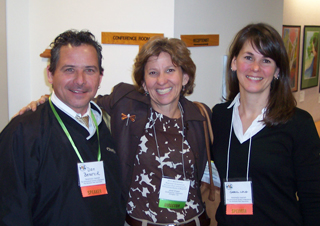 Dan Benarcik, Janet Draper, and Carol Long at the The Mid Atlantic Regional Symposium 2012, Baltimore, MD
Dan Benarcik, Janet Draper, and Carol Long at the The Mid Atlantic Regional Symposium 2012, Baltimore, MD
Photo: Steve Still
Dan Benarcik oversees the Courtyard Gardens of tropical, sub-tropical and tender perennials for seasonal display at Chanticleer. I couldn’t have guessed that a “Silver Cloud”-colored ‘65 Buick Rivera and minimalist xeric home plantings in Marfa Texas could have had such extensive influence on Dan’s garden in Delaware. Visit Chanticleer sometime, if you don’t believe me.
My topic was “The Company of Plantsmen.” I’ve presented different versions over the last fifteen years, but the focus has been on perennials and the endlessly fascinating people who have enriched my gardening life. I never have trouble coming up with interesting Jelitto Perennial seed recommendations (I am on the payroll) or colorful personalities.
It’s harder to illustrate how I ended-up as a gardener. The exploration can’t be easily explained in an hour. Attempts to untangle my web of influences and also sort out why we garden will bore the hardcore plant geeks who only want to see pretty flowers, but bear with me for one significant snippet from my past.
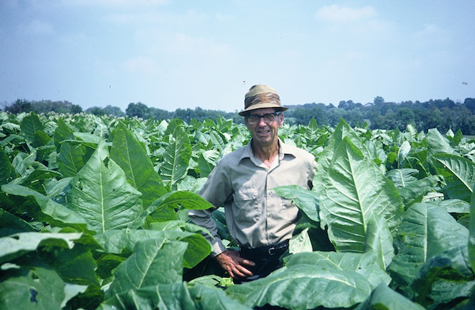
Elsie Lowery in his tobacco field, Jessamine County, Kentucky, 1974
Photo: Allen Bush
Elsie Lowery, who lived near Mount Lebanon, in Jessamine County, Kentucky, is a piece of my gardening puzzle. During college, I was living on a farm. It was high time – yes, it was – to sow some tomatoes and green beans and plant my first garden. Elsie, whose sister Odell Comley owned the small hill farm, said he would help. I studied old copies of Organic Gardening all winter and had a vision of a wonderful rectangular garden of mixed vegetables with some marigold and zinnias tossed in, too. What Elsie gave me was a garden that was 1 foot wide by 400 feet long, at the edge of his burley tobacco field. It wasn’t pretty but it was a beginning. I knew right away that I wanted to grow gardens for the rest of my life. I thank Elsie Lowery for saving my soul from law school.
I’ve pored over many photos to demonstrate how my own thinking has changed. I keep returning to over and over to images of two gardens from different ends of a spectrum. Major Lawrence Johnston, an American-born expatriate, built a 10.5-acre masterpiece on his family’s Hidcote Estate in Gloucestershire, England. Hidcote is a luscious garden – beautifully planted and perfectly tended. My other polestar is a photo taken by the late J.C. Raulston, an unidentified backyard in his native Oklahoma. It’s a photograph he used in lectures to demonstrate the ideal low maintenance garden. There’s really no garden at all. It’s little more than parched turf, and the photo always gets lots of laughs.
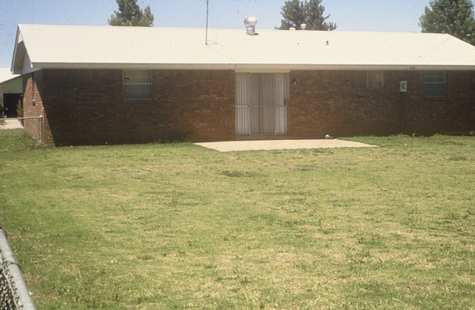
Oklahoma inspiration-maker
Photo: J.C. Raulston
Hidcote was my exemplar for many years. I couldn’t imagine anything else so exquisite in detail or execution. I’ve stared for years at a photo I took in 1980 of the summerhouse. I’ve looked through the doorway that led to a long border of sheared hedges and wondered so often: only if I could.
Well, I couldn’t. Hidcote is a manicured estate of hornbeams, perennial borders, topiaries and vistas. It gives the impression of idyll, beautiful and seemingly so carefree. Hidcote, one of the National Trust’s premier properties, with 150, 000 annual visitors, is fussed over by talented gardeners who give it this sleight of hand, contented look. Last year Hidcote completed a 10-year £ 3.5 million (over $5.5 million) makeover.
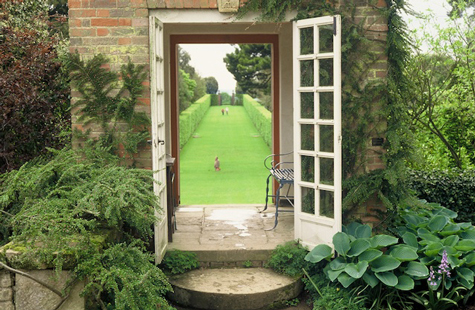
English inspiration-maker: Hidcote view, Gloucestershire, 1980
Photo: Allen Bush
I’ve been to Hidcote in the north Cotswolds, but I don’t have a clue where the Oklahoma garden-in-waiting might have been. Yet at some point – I don’t know when – I started to have a vision for this vacant backyard. A garden began to seem so doable here – and fun! I boldly imagined Hidcote’s grandeur on the suburban cheap.
Gradually, I started thinking about a small prairie or even a scree garden in the Oklahoma back lot. It wouldn’t need to be vast, complicated, or expensive. We could make a go at a mirror tree and string some carnival lighting from the gutters.
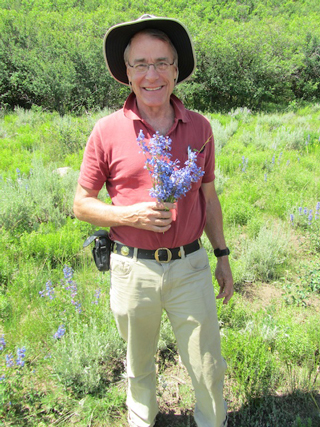 In full fancy, Allen Bush with Penstemon watsonii on the road to Flat Tops, Colorado
In full fancy, Allen Bush with Penstemon watsonii on the road to Flat Tops, Colorado
Photo: Georg Uebelhart
And Iet’s spice-up the night and put a couple of 3” thick porterhouse steaks on the grill, and set-up outdoor speakers and play Merle Haggard’s “Okie from Muskogee.” We can worry later about planting the brick rancher, but I’ve got some ideas: Sabal palms, the perennial Colorado four o’clock (Mirablilis multiflora) and the blue flowering Penstemon watsonii would be a good start. And I’d add the short red hot poker Knipfofia hirsuta ‘Fire Dance’ and Agastache ‘Tango’—the hummingbird mint that is ceremoniously shaded the 2012 Pantone Color of the Year: Tangerine Tango.
Chanticleer’s Dan Benarcik spoke prophetically in the Baltimore conference’s closing talk: “You don’t go looking for inspiration, it finds you.”
A garden starts as a fantasy drawn from a wellspring of such inspiration on the front end, and never ending chores on the back end. I’ll never garden in Oklahoma but I like the idea. Just as Moses likes his conception of a soccer field half a world away, in his native Nigeria.
Moses has talked, I’m sure, to a hundred rides since we met in Baltimore, and I have no doubt one day he’ll find the seed he needs. What a joyful creation that will be.

